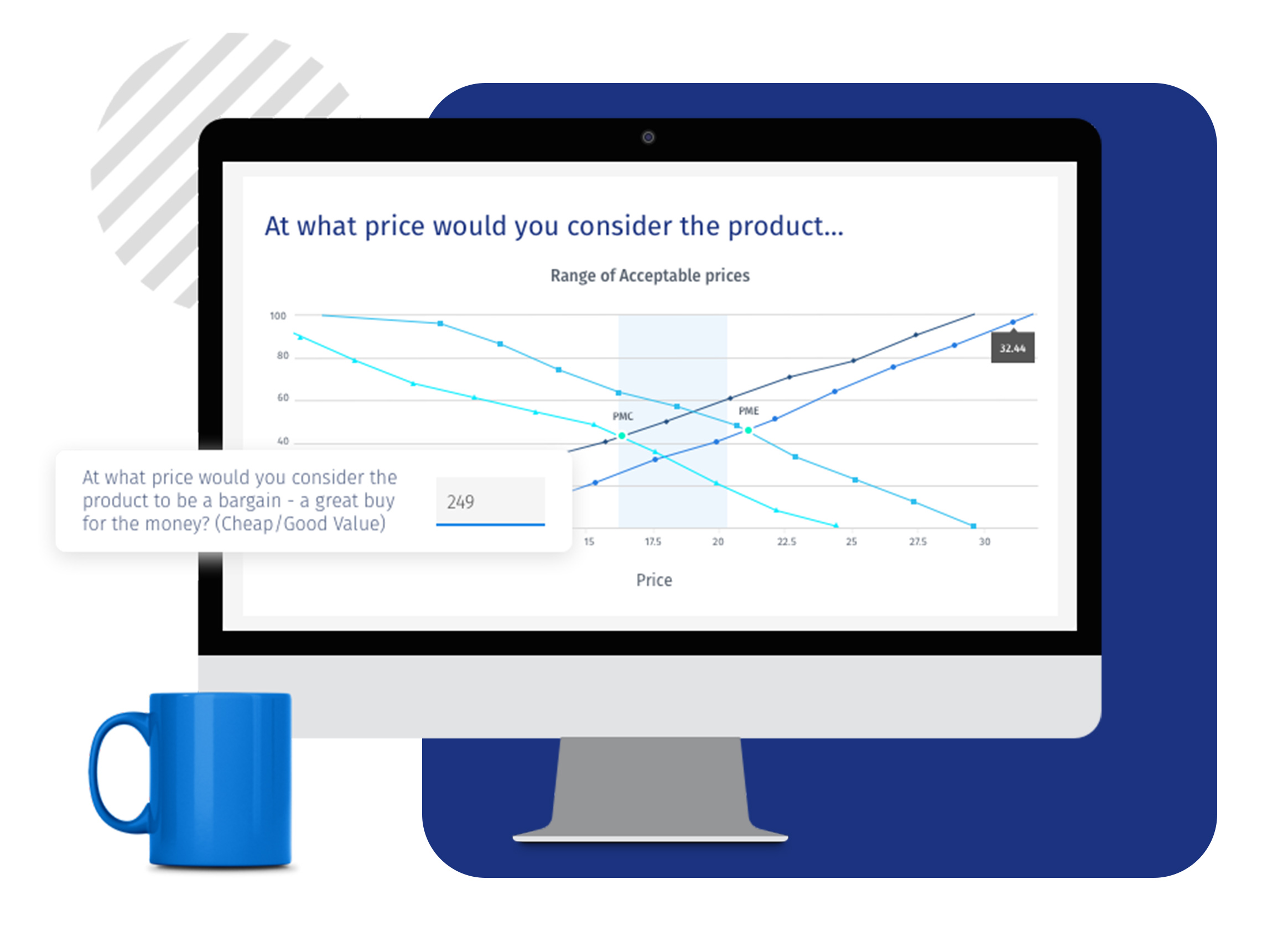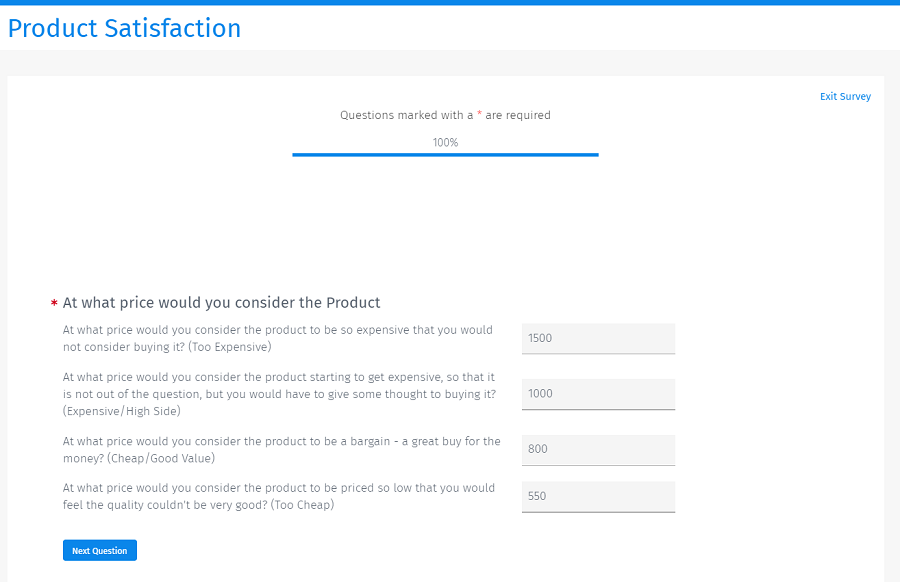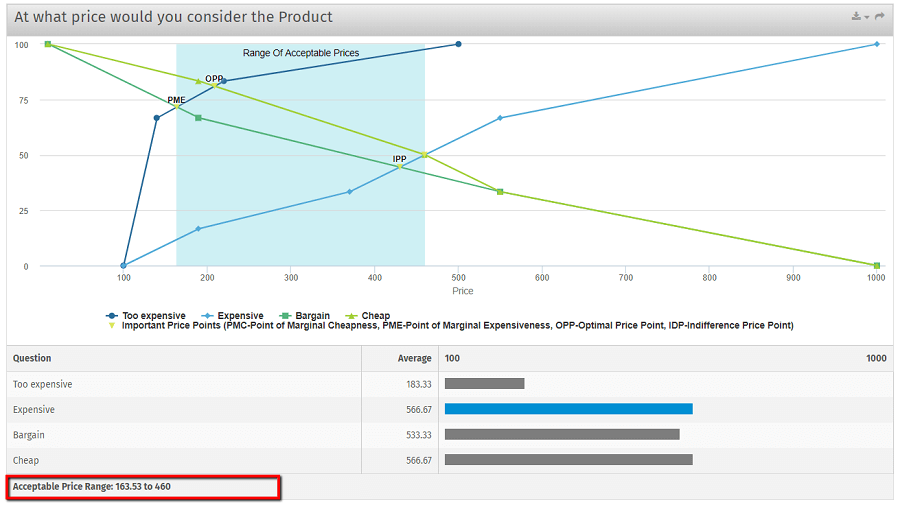The survey question helps understand consumers' purchase power and how much they're willing to pay. Companies can narrow down on the appropriate price of their product or service because the results they collect are from the real-world market.
Peter van Westendorp, a Dutch economist, developed the Van Westendorp survey question to highlight the range of prices the customers are comfortable with. The survey captures the change in their interest if the price falls. The price sensitivity survey question can be specifically useful if the marketer plans a pricing change, or wants to learn more about consumers' perceptions of their products vs. competitors' products.
Examples of Van Westendorp pricing sensitivity meter survey questions
Consider a consumer goods company that wants to launch a new product in the market. They can research what price customers are willing to pay for a fixed set of product features using the Van Westendorp index. The survey results will highlight the prices for a product that will help meet the company its sales target.
Organizations can also use this open-ended question to discover the just noticeable difference in the price while other attributes are kept constant. Van Westerndorp Price Sensitivity Analysis (PSA) can determine what change in price is acceptable to customers corresponding to change in features. People might value features more as compared to the price. In such a case, they might ignore the slight increase in the price. However, if the customers are too price-sensitive, they might notice even a slight increase in price. If this change is not acceptable to them, they might switch to competitors.
Companies that have already launched their products can understand how they can further increase consumption. Van Westendorp's price sensitivity meter will help them find how their consumers perceive their products in terms of value and price.

Van Westendorp pricing question in surveys
The Van Westendorp pricing research model asks four questions:
At what price would you consider the product to be so expensive that you would not consider buying it? (Too Expensive)
At what price would you consider the product starting to get expensive, so that it is not out of the question, but you would have to give some thought to buying it? (Expensive/High Side)
At what price would you consider the product to be a bargain - a great buy for the money? (Cheap/Good Value)
At what price would you consider the product to be priced so low that you would feel the quality couldn't be very good? (Too Cheap)
Choose from one of QuestionPro’s editable Van Westendorp survey template to build a quick survey. You can also customize the questions to suit your needs.
Min value: Set the minimum amount below which respondents cannot enter the price.
Max value: Set the maximum value above which respondents cannot enter the price.
Reverse order: Reverse the order of Van Westendorp questions.
Question width: Adjust the width of the questions so that they are easy to read and look visually appealing.
Add prefix/suffix to textbox: Add the prefix or suffix to the textbox in the answer choices. You can use this option to add the currency code, units, etc
You can also set a custom report label and scale type. To share the survey report, you can share the report link with others or use a link to embed it on your website. You can also download it in the form of excel.
Analyzing responses of Van Westendorp question
You can analyze the survey results on the dashboard and report.

The intersection of specific data points gives an idea about how respondents view price-value through the Optimal Price Point (OPP) and the Indifference Price Point (IDP). At OPP, an equal number of respondents consider the price as 'too expensive' or 'too cheap'. At IDP, an equal amount of participants believe the price is either 'cheap' or 'expensive'.
You can find the Point of marginal cheapness (PMC) - the price point where you will lose more sales due to poor quality than would be won from bargain hunters. The Point of Marginal Expensiveness (PME) is the price point above, which price is a significant concern. Here the respondent feels that the product is too expensive.
Between PMC and PME is the Range of Acceptable Prices, which can be used by market researchers to decide the optimal price. This range of price also implies the rate expected by consumers.
Advantages of Van Westendorp survey analysis in market research
Discover acceptable pricing: Companies can launch new products with a pricing strategy that is likely to succeed. They will be better prepared to know optimal price points and an acceptable price range to meet sales targets.
Find the relationship between price and features: Learn how pricing affects the buying decisions.
Know the best possible combination of price and features: Based on what consumers consider affordable or expensive, product managers can bundle the best possible combination of features at a specific price. Companies can plan their go-to-market strategy with the confidence that the customers will accept their products and services.
How to use Van Westendorp price sensitivity meter question in your surveys?
Learn more about this feature and how to add this question with our help file on Van Westendorp's question.
Survey Software Easy to use and accessible for everyone. Design, send and analyze online surveys.
Research Suite A suite of enterprise-grade research tools for market research professionals.
Customer Experience Experiences change the world. Deliver the best with our CX management software.
Employee Experience Create the best employee experience and act on real-time data from end to end.







